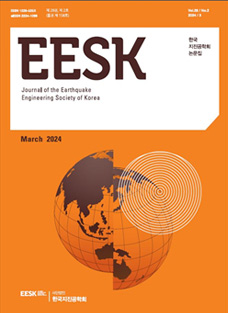1. Introduction
The auxiliary building in NPP is designed to maintain its structural integrity following a safe-shutdown earthquake (SSE) and to perform its intended function following a postulated event, such as fire NRC [1]. Auxiliary building in NPP is very important in the context of safety assurance and running the production process of NPP because it contains radioactive waste systems, chemical and volume control systems, and emergency cooling water systems. Generally, this auxiliary building develops with a shear wall system to ensure the safety deemed as complied with all regulatory requirements for the safety of NPP. To ensure the safe and reliable function of these and reliability requirements. Shear wall systems that are designed and constructed agreeing to codes and standards are buildings, it is vital to evaluate the dynamic behavior, in particular the behavior under the earthquake loading. this is essential to identify and quantify the characteristics of these buildings to provide guidelines for the future design and assessment of similar buildings.
The shaking table test is one of the most extensively used methods to assess the seismic characteristics of structures [2]. For assessing the elastic or inelastic dynamic response behavior of structures is usually used. Many researchers already investigate the dynamic characteristics of shear wall systems through shaking table tests. Li et al. [2] demonstrated the seismic performance analysis of a high-rise RC shear wall structure with a 1/30 scale model, where dynamic characteristics and the seismic responses of the model due to various seismic intensities are investigated through shaking table test. A simulation of nonlinear dynamic responses of 7 stories full-scale RC shear wall structure via shaking table test considering four earthquake records of increasing intensity for the base excitation was investigated by Martinelli and Filippou [3]. He et al. [4] presented the benchmark results for the verification and improvement of a refined multi-scale numerical simulation method for non-linear behaviors of reinforced concrete shear wall model structures. Ghorbanirenani et al. [5] conducted a shaking table test to investigate the inelastic response behavior of an 8 story moderately ductile RC shear walls excited with expected high-frequency ground motion. Besides these Li et al. [6], Sun et al. [7], Ye and Jiang [8], Qin et al. [9], etc. researchers also undertook the shaking table to identify and qualify the dynamic responses characteristic of shear wall systems. Most of the researcher developed the finite element model (FEM) to validate and make useful in engineering aspects. Based on several blind contests demonstration, the modern FEM methods are still not enough precise to capture the inelastic/non-linear dynamic characteristics in concrete structures [4, 10]. According to He et al. [4], a large disparity still exists between the FEM simulation and the test results if the structure contains robust non-linearity/inelasticity.
This work aims to subject the experimental contributions that the Round Robin Analysis has allowed to reach. In specific, the main contribution of the experimental part of the project lies in the fact that the auxiliary building model consists of shear wall systems for NPP that was tested under different excitation intensities. This paper is summarized as follows. Firstly, the experimental shaking table test program was carried out within the framework of the Korea Atomic Energy Research Institute, South Korea. The details of designed test specimens are described in detail. Secondly, the modal parameter is identified. The fundamental modal frequency, mode shapes, and modal damping ratio are extracted using the least-squares complex exponential estimation from the sensors data of the shaking table test. Thirdly, the floor responses are characterized by the acceleration amplification factor and story shear force. Fourthly, the nonlinear FEM is generated by using the layered shell shear wall element for effective use in engineering purposes, consequently, the validation and verification is demonstrated through the acceleration responses from experiment and finite element analysis (FEA).
2. Experimental plan and program
Korea Atomic Energy Research Institute (KAERI) organized joint research on the Round Robin Analysis for evaluating the dynamic characteristics and to verify the numerical analysis methods for shear wall structures e.g. auxiliary buildings of nuclear power plants. To verify the results from numerical analysis results, a three-story concrete shear wall structure was fabricated and the experiment was performed (Fig. 1). This experimental program was allotted with the shake table facility at the Earthquake Disaster Prevention Center, Pusan National University. Preliminary the model was excited by random vibration with low intensity (peak acceleration 0.05 g) to capture linear response characteristics, natural frequencies and vibration modes. In this stage, no damage was expected to occur in the model. Then the large-intensity seismic excitations were applied to exhibit the strong non-linear behaviors of the model. To avoid the complexity in revealing nonlinear behaviors of the model, the model was subjected to seismic excitation in only one single horizontal (y) direction, i.e., the in-plane direction of side shear walls. Fig. 2(a) shows the geometry features of the tested building model. The details of the model are presented in Table 1. The concrete had a compressive cylinder strength of 30.4 MPa and, while the steel grade was SD400. The reinforcement details of the fabricated model for the X-X and Y-Y section are shown in Fig. 2(b) and Fig. 2(c) respectively.
Different arrays of sensors were installed for the test model to record its dynamic response under random vibration and earthquake excitation. In the case of random vibration responses, 8 single-axis accelerometers are used directly to record the response acceleration of the model. The location for these 7 accelerometers was different for the responses of X and Y direction. The sensor's location array for X and Y directional responses are shown in Fig. 3(a) and Fig. 3(b) respectively. Fig. 3(c) and Fig. 3(d) represents the sensor’s arrangement to get Y directional responses under earthquake excitation.
The loading sequence is composed of 5 main uniaxial earthquake excitation runs in the horizontal Y direction. The peak table acceleration (PTA) of each excitation increased as the following intensity level (IL): 0.28 g – 0.28 g – 0.50 g – 0.75 g - 1.00 g. Gyeongju earthquake (EQ), 2016 (Myeonggye-ri, N-S direction) was chosen as input earthquake excitations in sequence in the test. This earthquake was magnitude (ML ) up to 5.8. which was felt over most of the southern Korean peninsula. The ML 5.8 shock is the biggest earthquake in the history of instrumental observation of Korean earthquakes which began in 1905 [11]. The recorded Gyeongju EQ time history acceleration and spectral data are shown in Fig. 4(a) and Fig. 4(b) respectively. Some basic information of unscaled record is shown in Table 2. After each seismic excitation, the frequency search test was conducted to gain the dynamic properties of the test structure.
3. Numerical modeling
In this study, The finite element model (FEM) of the auxiliary building with the shear wall system was developed by the open-source software OpenSees [12]. In terms of different types of materials, elements, solution algorithms, and other capabilities, OpenSees is one of the most powerful open-source platforms [13]. For the model visualization and post-processing, FeView [14] software was considered throughout the study.
Here, RC shear walls were modeled using the multilayer shell element (LayeredShell) developed and validated for the OpenSees platform by Lu et al. [15] which modeling approach is capable of simulating the complex behavior of RC shear walls. The concrete and steel rebar are considered as several fully-bonded layers along with the thickness of the shear wall. Within the multilayer shell element, the curvature of the mid-layer is calculated initially and the strains of other layers are along these lines decided to utilize the plane-section assumption. The stresses of integration focus on layers are consecutively obtained utilizing the constitutive material model of layers. It is expected that the stress is steady along with the thickness of a layer. In this manner, the stress dispersion along the thickness can be suitably captured by partitioning a shear wall into an adequate number of layers [13]. The material properties and thickness of each layer are assigned following the details of the shear wall Fig. 2(b) and Fig. 2(c). A total of eight layers was constructed to define the shear wall properly Up to the mid-layer the layers (four layers) were for cover concrete, transverse rebar, longitudinal rebar, and core concrete as shown in Fig. 5.
The “LayeredShell” element is incorporated with the ShellMITC4 element, which employments a bilinear isoparametric definition in combination with a modified shear introduction to improving thin-plate bending execution. Lu et al. [15] propose the mathematical model for nonlinear concrete based on the damage mechanics and the smeared crack model, in which cracking, crushing and aggregate interlocking are incorporated in the planar concrete constitutive model. For rebar material, the nonlinear behavior of yielding and the Bauschinger impact are taken into thought in its uniaxial demonstration. The concrete and steel material properties are enlisted in Table 3.
The finite element model (FEM) for the shear wall specimen is illustrated in Fig. 6(a). The maximum mesh in the model was assigned as 0.15 m. As already explained the wall was modeled by a multi-layer shell element considering material constitutive material model but the slab and the base were modeled with elastic shell and elastic solid brick element respectively. It is assumed that the floors displace as rigid bodies and the story shears and torsional moments are distributed to the vertical wall in proportion to their relative stiffnesses. So, the rigid diaphragm on each floor as perpendicular to the X-Y plane (3 axes) was applied. In this numerical model, the floor mass was supported by the corresponding floor diaphragm. The total mass of the specimen body was (22170 kg) which was distributed on each floor as shown in Fig. 6(b). The Mass of M1, M2 and M3 was calculated as 7991 kg, 7390 kg and 4561 respectively. The translational and rotation degree of freedom was set to zero for defining the support.
The non-linear dynamic investigation was carried out by implementing the direct integration technique. The investigation was conducted with the gravity load because of its self-weight and input acceleration of selected earthquakes as the static load and seismic load respectively. The following dynamic equation of motion will justify the above-discretized FEM system.
where [M], [C], [K] and {x} denotes the model mass, damping, stiffness matrix and coordinate vector respectively. is the shaking table acceleration and {f} is the total pre-seismic load associated with the gravity.
4. Modal parameter identification
Modal parameter estimation (MPE) is the main stage for the evaluation of dynamic characteristics or structural damage revealing and structural health monitoring (SHM). There is a lot of identification algorithms already developed for both outputs-only responses [16, 17] or input-output responses [18, 19]. The most MPE is constructed upon the experimental/measured data being the frequency response function (FRF) in the frequency domain or impulse response function (IRF) in the time domain. Notwithstanding the form of the measured data, the MPE methods have usually been divided into two categories: (1) single degree of freedom (SDOF) approximations, and (2) multiple degreeof- freedom (MDOF) approximations. In this study, input-output responses and MDOF approximation were considered to extract the modal parameters. The MPE can be explained briefly by the flowchart shown in Fig. 7.
Using the discrete Fourier transform (DFT) algorithm, the measured data from the shake table experiment can be converted by the following equation [20].
for k = 1, 2, , …N are called the Nth roots of unity and the sequence Xk is the DFT of the sequence xj. Each is a sequence of N complex numbers.
The FRF is a complex function, which is defined over a specified frequency range [21], which defined as the ratio of the output signal to the input signal [22], i.e.,
Here, for determining the modal parameters Least-Squares Complex Exponential (LSCE) method was used which was introduced by Brown et al. [23]. Even though the LSCE uses FRFs as an input, it goes in the time domain. This is succeeded by calculating impulse response functions (IRFs) from the FRFs by inverse Fourier transformation. The IRFs can be expressed by a superposition of complex exponential response terms [24]:
The product of time-independent residue ar and a time-dependent complex exponential function is a decaying transient modal response that can get from each of complex exponential response terms. The ar represents local quantities that depend on responses and record numbers and are global quantities, which depend on the complex eigenvalues λr of the systems.
Based on Prony’s method [25], the influence of the local quantities can be separated from the influence of the global quantities so that the system poles λr can be calculated from the roots of the following polynomial equation [24]:
where and have been presented with N amplitudes and poles. In this equation, αn are polynomial coefficients which can be identified from the IRFs of L = 2N samples as follows:
where hn = h(tn). Equation 6 can be constructed using a different set of data points and, also, the new data points to considerably overlap with the previous set can be used. Therefore, an over-determined equation system can be made from which the polynomial coefficients αn can be determined by using the least-squares algorithm. Once the polynomial coefficients αn are identified, the z-domain poles λr can be obtained from the roots of equation 5, and then, the system poles λr can be deduced by applying the reverse substitution . Once the system poles λr are determined, it is possible to determine the mode shapes and modal scaling constants can be identified, either by curve-fitting the measured FRFs.
5. Result and Discussion
5.1 Modal parameters
In this study, the LSCE method was used to determine the modal model parameters, by which the correlation function is approximated by the sum of exponentially decaying harmonic functions. Before going to the main experiment the auxiliary building was excited by white noise with low intensity to know the elastic properties of the building, which already explained in the previous sections. Individual excitation was conducted for X and Y directional responses. In both cases, 8 sensors (Acc. 1, Acc. 2, Acc. 3, Acc. 4, Acc. 5, Acc. 6, Acc. 7 and Base) was installed as shown in Fig. 3(c) and Fig. 3(d). For convenience to the analysis, the sensor locations data is divided into two sets i.e. Set 1 (Base, Acc. 7, Acc. 6, Acc. 5, Acc. 4, Acc. 3 Acc. 1) and Set 2 (Base, Acc. 7, Acc. 6, Acc. 5, Acc. 4, Acc. 3 Acc. 2).
Fig. 8(a) and Fig. 8(b) show the resulting stabilization diagram of the auxiliary building for an expected number of modes (model order) ranging up to 30 in the frequency range of 1 to 100 Hz. Circular markers indicate stable poles in frequency, plus-shaped markers indicate the poles are stable in frequency and damping both, and the dot is unstable. Moreover, the average response function (mean FRF) is shown by a solid red line to facilitate the distinction between physical and non-physical poles. From Fig. 8(a) and Fig. 8(b) it can be shown, the fundamental natural frequency (black dotted line) for this structure is 16.09 (considering Set 1) and 23.06 (Considering Set 1) in X and Y-direction respectively. Also, various stable poles indicate a series of additional higher modes in the target frequency range. However, for numerical model updating mode 1 and mode 2, whose frequencies and damping ratio are listed in Table 4. Fig. 9 shows the mode shapes from the LSCE estimation as well as the numerical model. Mode 1 and mode 2 are consisting of the behavior of translational (X-direction)-torsional and only translation (Y-direction) effect respectively. In this structure mode, 2 is very important because of in-plane (sidewall) actions. It indicates that the Fundamental modal frequency and mode shapes from the numerical model is identical to the shake table test. In the context of the verification and validation, It can be assured that this numerical model can be used for further investigation. From the LSCE the damping ratio for the fundamental modes varies from 3.18 to 3.74. For the response characterization through time history analysis (THA) the average damping ratio (3.40%) was used.
The damage of the structure can be evaluated by the shifting of frequency of the structure. Generally, after reaching the yielding point the stiffness of the structure reduce as well as the frequency also reduces. The frequency search test was conducted to gain the dynamic properties of the test damaged structure after each excitation (0.28 g, 0.50 g, 0.75 g and 1.00 g). Table 5 shows, after 0.75 g there has little shift in frequency but not remarkable. It means the structure is nearly damaged free up to 1.00 g.
5.2 Floor response spectra (FRS)
This part compares the numerical analysis and measured (by shake table test) auxiliary building responses of each floor to the seismic input excitation with different peak acceleration (0.28 g, 0.50 g, 0.75 g and 1.00 g). The sensor's configuration during the shaking is shown in Fig. 3(c) and Fig. 3(d). Here, the responses from the accelerometer located at mid of each slab i.e. F2P2, F3P3 and F4P4 consider for the 1st, 2nd and 3rd-floor responses respectively.
For analyzing the performance of the numerical model in earthquakes and assessing the peak response of building to the earthquake, the floor response spectra plot considering the damping ratio as 3.4% (measured from shake table test) for each floor were generated. The piecewise exact solution was used to compute floor response spectra. The results were compared with the numerical analysis and shake table test which is shown in Fig. 10. The comparative study shows that the responses from each floor (1st, 2nd and 3rd) have a great agreement between analysis and test results except 1.00 g. Based on Shah [26], Nahar et al. [27], the error from the FEM should be less than 15%. Table 6 represents the error of FRS on resonance frequency (Mode 1 and Mode 2). Table 7 shows that the maximum error on peak acceleration is considering each floor and excitation level.
The error of FRS and peak acceleration is 13.94% and 13.83% respectively, which are within the acceptable limit.
5.3 Acceleration amplification factor
The acceleration amplification factor (AAF) is typically defined as the ratio of the peak floor acceleration (PFA) value to the peak table acceleration (PTA) (or input) is used to evaluate acceleration vibration amplification effects at different floors level. The AAF is mainly used for the non-structural component (NSC) seismic demand estimation. The profiles of AAF for the analysis and test are shown in Fig. 11. Besides these, the AAF results also compare with the existing simplified model proposed by FEMA-P58 [28] and ASCE7 [29]. The mathematical formulation proposed by FEMA-P58 and ASCE7 can be express by the equations 7 and 8 respectively.
where AAFi, hi H , S represents the AAF at a specified floor (i), the height of a specific floor from the base, the total height of the building, and the ratio of the elastic response spectral acceleration at the fundamental period, multiplied by the total mass, to the yield strength of the building. T1 is the fundamental modal period of structure (In this study mode 2). Based on FEMA-P58, the values of the regression coefficients a0, a1, a2, a3, a4 and a5 are 0.66, -0.15, -0.084, -0.26, 0.57, and 0 respectively, which is applicable for the shear wall system and building height range 2 to 9 story. The acceleration distribution over the building height shows a similar distribution between analysis and test except for 1g. For the top floor AAF, the approximated AAF by FEMA-P58 supports the analysis and as well as experimental results. But, in every case, the ASCE7 gives the overestimation of AAF. So, the approximation formula as shown in equation 8 does not relay for the shear wall system.
6. Conclusion
This paper describes a shake table test and numerical modeling on a three-story shear wall building (auxiliary building in NPP) structure. The KAERI arranged joint research on the Round Robin Analysis for this shear wall to verify the numerical analysis methods with the experiments. The test was carried out for the random excitation and Gyeongju EQ (2016) excitation with different IL (0.28 g, 0.50 g, 0.75 g, and 1.00 g). Besides, the frequency search test was conducted after each IL of EQ to know the global internal or external damage status of the structure. In contrast with the experiment, The numerical model for the specimen was developed based on the multi-layer shell element which is capable to simulate the complex behavior of RC shear walls. Consequently, from the test and numerical analysis results the following conclusions can be drawn:
-
∙ The multi-layer shell element captures the real behavior of the shear wall systems. The elastic dynamic modal properties i.e. mode shapes and modal frequency give great agreement with the test results. The error in the modal frequency for the first and second modes is 1.62% and 0.35% respectively. The experiment and numerical model predict the modal behavior with translational-torsional and only translational effect for first and second mode respectively.
-
∙ From the frequency search test results, it shows that there has little shift in modal frequency after excitation IL of 0.75 g which is 2.48% (first mode) and 1.16% (second mode). It means there has no considerable damage in the specimen and it didn’t behave the full nonlinearity. Also, in the numerical, there has no significant damage up to the maximum IL i.e. 1.00 g.
-
∙ From the floor response spectra, the shape of the top floor (third) response spectra looks very similar to the test results except for 1.00 g. The response is large in the resonance band in 1.00 g for numerical analysis. Generally, after reaching the damage, the damping ratio of the structure reduces. Although there have no remarkable damage eventually a little damage should be induced after 0.75 g as the frequency shifting (up to 2.48%) occur. However, during the numerical analysis, these changes of damping didn’t consider as a result it shows the large responses then experiments. Also, the error for FRS and peak acceleration are maximum (14.33% and 13.83% respectively) at excitation level 1.00 g although it’s within the acceptable limit.
-
∙ The profile of the floor amplification factor represents a similar manner from experiments and numerical analysis. But for the IL of 1.00 g, it gives a large value because of the same reasons as explained for response spectra. For the top floor AAF, the predicted values by FEMA-P58 supports the experiments and the analysis numerical results. But, in every IL of EQ, the ASCE7 gives the overestimation of AAF. So, for the shear wall systems, the AAF doesn’t count on on the predicted formula by ASCE7.






























